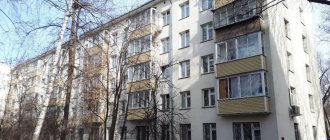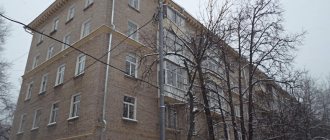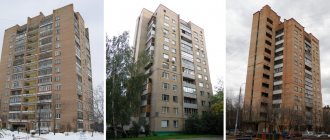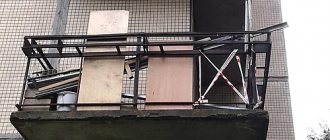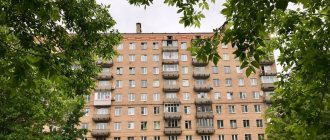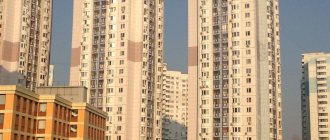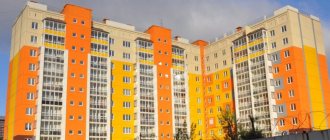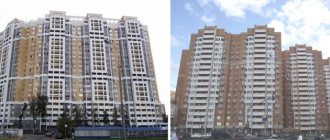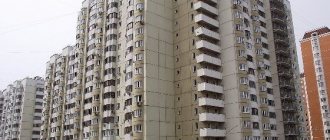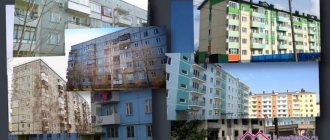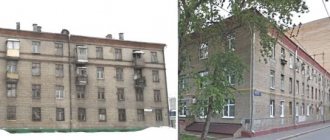A series of five-story brick houses I-511, as well as its modifications, were designed by the Moscow specialized architectural and design bureau (SAKB), on the basis of which the MNIITEP design institute was later organized.
Photo of the house series 1-511
Houses of this series were built en masse in Moscow from 1958 to 1969, but some, mostly departmental ones, continued to be built until 1975. In total, about 1,700 houses belonging to this series were built in the capital.
| House type | Brick |
| Type of sections | End, ordinary, at least 2 entrances |
| Ceiling height | From 2.48 to 2.7 m (in early houses) |
| Heating | Central, water |
| Water supply | Hot and cold water supply from city networks, and also, where there was no hot water supply, geysers were installed. |
| Type of cookers | Gas. |
| Building construction | External walls are most often made of slotted brick, 38-40 cm thick (in early houses made of silicate brick, 51 cm thick). The interior walls and staircase walls are brick, 27–37 cm thick. Interior partitions are gypsum concrete, 8 cm thick. The floors are prefabricated, made of reinforced concrete hollow-core slabs 22 cm thick. Load-bearing walls - external, inter-apartment and staircase walls. |
| Elevators | No, but in some houses they were installed during reconstruction. |
| Ventilation | Natural exhaust through shafts in the kitchen and bathroom |
| Garbage removal | There are no garbage chutes |
Typical layout of apartments in a building of series 1-511
Features of buildings series 1-511
There are 4 apartments on each staircase in the series of buildings. In most versions of the series, all apartments, starting from the 2nd floor, have balconies.
The first floors are most often residential. The design of the technical underground, where the utilities are located, makes the first floors quite high.
Bathrooms in 1-room apartments are combined, in 2- and 3-room apartments – separate.
Bathtubs: standard (not shortened - sit-on). In the earliest houses, all apartments had combined bathrooms.
In the first years of construction of the series, houses were made with hipped roofs. Then they began to use flat roofs with a slight slope on two sides.
Features of the series and layouts
In total, about fifty modifications of standard housing were developed and built in 1958–1969. Panel high-rise buildings were erected by the government of the country to quickly relocate people from villages to cities. A feature of Khrushchev apartments is small-sized apartments, which is also different from series 1 511. Buildings of this type were built en masse in Moscow and the Moscow region. Their total number is 1670. The houses are easily recognized by the symmetrical arrangement of balconies on both sides of the front door. The entrance has a canopy made of reinforced concrete slab.
Buildings built in the late 50s and 60s vary in roof construction and layout. There is a difference in ceiling heights. In 1958, silicate bricks were used to build walls, later silicate-hydrohelium and seven-slit bricks were used. The early versions of the i 511 series houses had a hipped roof with slate or roofing iron decking. Buildings built in 1964–1969 had a flat roof with a gable slope and covered with rolled roofing felt waterproofing. Other features of series 1 511 houses:
- Combined stairs without a common fire balcony.
- Brick load-bearing walls.
- The interfloor floors are 22 cm thick, made of reinforced concrete hollow-core slabs.
- A large selection of redevelopment options, the possibility of demolishing interior walls.
- The toilet and bathroom are combined in one-room apartments. Bathrooms in all apartments with more than two rooms are separate.
- The ceiling height is 2.78 m in houses from 1958 and 2.48 m in later versions.
- Ventilation – natural exhaust.
- Kitchen stoves are gas.
- Ordinary type of sections, the number of entrances in the house is from 2 or more.
- There are 4 apartments on the site.
- Lack of elevators.
In large numbers, series 1 511 houses have 5 floors, but there are also 3-story buildings. This type differs from other Khrushchev houses by its brick external walls 38–40 cm wide. In such houses, heat is well retained and noise from the street is not heard. The thickness of the interior walls is 8 cm, they are made of large-panel gypsum concrete.
Houses of series 1 511 are not subject to dismantling due to the good condition of structures and communications. There are known episodes of demolition in some cases: during the complex reconstruction of residential areas in Moscow.
Studio apartment
The dimensions of a one-room apartment of series 1 511 are from 28 to 30 m2. Of these, residential – 15–19 m2. Kitchen area from 5 to 6 m2. Combined bathrooms. Features of the housing include storage rooms and mezzanines. The hallway measures between 3–4 m2.
You may be interested in: Characteristics of the P-3M series house: apartment layout
Two-room
The total area of a two-room apartment is 44–48 m2, living area is 28–32 m2. The size of the kitchen is the same as in one-room apartments. Bathrooms are separate. To save energy, developers in 1969 installed windows between the kitchen, toilet and bathroom. The layout of Khrushchev-era apartment buildings is considered to be inconvenient, but the area of the apartments is no different from the standard for residential premises in 2021.
Three-room apartment
In some of the houses of standard series 1 511, the apartments have walk-through rooms. There are two built-in wardrobes in three rubles. The bathrooms are separate; windows are installed in the partitions in the bathroom and toilet to save energy by the owners. The total area of a three-room apartment is 53–57 m2, living area is from 38 to 42 m2. Kitchen size – 5–6 m2. Early versions of houses tend to have high ceilings (2.72 m). In buildings from 1964–1969 - standard (2.5 m). The balcony in most cases is adjacent to the living room.
Apartment areas and layouts in buildings 1-511
In the houses of series I-511, some of the 2- and 3-room apartments have adjacent rooms; in the corner 2- and 3-room apartments, all rooms are isolated.
| Apartment areas | Total m² | Residential, m² | Kitchen, m² |
| 1-room apartment | 28-30 | 15-19 | 4.8-5.7 |
| 2-room apartment | 40-44 | 28-33 | 4.7-5.6 |
| 3-room apartment | 53-57 | 38-43 | 4.7-5.6 |
The 4-room and 5-room apartments available in some buildings were created by combining apartments of smaller area.
In modification 1-511-130-37, intended for small-family occupancy, all apartments are one-room, with kitchens with an area of just over three square meters and showers.
Examples of BTI plans for series 1-511 with dimensions
Redevelopment options
The demolition of partitions that are not load-bearing does not require approval from the Moscow Property Committee. However, after reconstruction, the supervisor must be notified and a new plan must be submitted. The same applies to the glazing of loggias. However, there are several solutions that will lead to problems when coordinating redevelopment:
- Combining a kitchen with a gas stove with a room without installing a sliding partition.
- Placing a toilet or bathroom above the neighbors' living space.
- Relocating the kitchen to a room or bathroom.
Also, unauthorized changes in the position of radiators threaten a lawsuit from neighbors. Selling such an apartment will become impossible. The best solutions for increasing living space in houses of the 1 511 series:
- Combining rooms with balconies.
- Relocating doorways in load-bearing walls.
- Replacing a gas stove with an electric one and then setting up a studio.
- Combination of bathroom and toilet in 2- and 3-room apartments.
Free ready-made apartment redevelopment projects for standard series of houses are provided by the Moscow Housing Inspectorate on its own official website.
Buildings of series 1 511 have thick brick walls, they are warm in winter, cool in summer, and no extraneous sounds are heard from the street. However, the layout of the housing is inconvenient for people to stay in them. Comfortable conditions in the house of series 1 511 will be created by redevelopment. An alternative to renovation can be zoning the room and replacing bulky furniture with multifunctional ones.
Pros and cons of the 1-511 series for redevelopment
The advantages of the series include the presence of concrete interfloor ceilings and the absence of load-bearing walls in the areas of most apartments.
The downside is the lack of auxiliary (non-residential) spaces between the bathroom and living space in some apartments.
The plans show that in one-room apartments, as well as some two-room apartments, it is almost impossible to carry out redevelopment with the expansion of the bathroom - there are no corridors, and the bathroom borders the living space. In addition, when remodeling apartments in the 1-511 series, you need to take into account the presence of gas stoves and water heaters.
Houses 1–511
The construction of three to five-story buildings was carried out in 1958–1969.
In Moscow you cannot find an area in which there would not be houses of the 1-511 series. Old brick five-story buildings give a special flavor to the Presnensky district, Taganka, Preobrazhenka. Thanks to these buildings, Bogorodskoye, Perovo, Khoroshev-Mnevniki, Golyanovo, Shchukino, Kuntsevo, Airport, Degunino, Khovrino, Metrogorodok, Izmailovo, Marfino, Golovino, Mikhalkovo Koptevo and many others look like cozy corners of the capital.
In the Moscow region, construction was carried out in Balashikha, Aprelevka, Khimki, Golitsino, Lobnya, Odintsovo, Pushkino, Kotelniki, Monino, Dzerzhinsky, Reutov, Lyubertsy and Zheleznodorozhny.
Since the buildings were made entirely of brick, only individual representatives of the series were included in the plans for the demolished houses. There are no plans to replace these buildings on a large scale yet.
Possibilities for redevelopment of apartments 1-511
The main task of optimizing the layout of apartments in houses of the 1-511 series is to free up space as much as possible from unnecessary partitions and provide storage space. To this end:
- in the corridors, non-load-bearing partitions are dismantled, sometimes combining the living room with the hallway, which allows for a visual expansion of the space;
- built-in wardrobes and wardrobes are installed in the niches;
- combine a bath and toilet, increasing their area due to the corridor;
- the entrance to the kitchen is moved to the living room to make it a dining room;
- in three-room apartments, the passage room is isolated, and a wardrobe is made in the formed niche, etc.
Non-load-bearing partitions allow you to experiment with configuration. Changing the location of plumbing equipment requires installing waterproofing, and moving the entrance to the kitchen requires installing tight doors, in accordance with the requirements for gasified buildings. Any changes to the layout are approved after drawing up the project.
The need and possibility of redevelopment
The small corridor at the entrance to the food preparation area is difficult to use and instead of almost five meters, the kitchen takes up no more than 4.5 m. Dismantling, moving or shortening partitions helps us get rid of unproductive space.
The size of the toilet room in apartments with a separate bathroom is 0.98 square meters. m. In most cases, customers agree to combine two premises into one. This creates space for installing a washing machine and room for maneuver.
Some apartments have walk-through rooms. Our designer has developed several options for moving walls to create isolated rooms. Most projects provide for the organization of a dressing room.
Since there are no permanent partitions in the apartments of series 1–515, redevelopment does not pose any particular difficulties. It is important to remember that when removing, shifting, or changing the configuration of walls, new plans must be approved by the Moscow Housing Inspectorate. Drawings prepared by the architect always undergo approval.
Complete turnkey apartment renovation
- Everything is included The cost of repairs includes everything: work, materials, documents.
- Without your participation After agreeing on the project, we only bother the owners when the repairs are completed.
- The price is known in advance. The cost of repairs is fixed in the contract.
- Fixed repair period Turnkey apartment renovation in 3.5 months. The term is fixed in the contract.
Read more about Done
